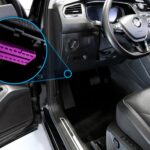OBD2 and EOBD codes, also known as Diagnostic Trouble Codes (DTCs), are alphanumeric codes that indicate potential problems within a vehicle’s systems. Understanding these codes is crucial for effective vehicle diagnostics and repair. This guide will explain how to retrieve and interpret these codes.
Understanding OBD2 and EOBD Systems
OBD2 (On-Board Diagnostics II) is a standardized system used in most gasoline-powered vehicles manufactured after 1996 in the United States. EOBD (European On-Board Diagnostics) is a similar system used in European vehicles. Both systems monitor various vehicle components related to emissions and performance. When a problem is detected, the system’s Electronic Control Unit (ECU) stores a corresponding DTC.
Retrieving Diagnostic Codes: A Step-by-Step Guide
Accessing OBD2 and EOBD codes involves a few simple steps:
1. Locate the OBD2/EOBD Port
The port is typically located under the dashboard on the driver’s side, often near the steering column. It’s a 16-pin trapezoidal connector.
2. Connect an OBD2 Scanner
An OBD2 scanner is a handheld device that connects to the port. Various types are available, from basic code readers to advanced scan tools with live data capabilities.
3. Read the Codes
Turn the vehicle’s ignition to the “on” position (do not start the engine). The scanner will power on and communicate with the ECU. Follow the scanner’s instructions to retrieve the stored DTCs. The scanner will display the codes.
Deciphering Diagnostic Trouble Codes
OBD2 and EOBD codes follow a standardized format:
- First Character: Indicates the system related to the fault (P: Powertrain, B: Body, C: Chassis, U: Network).
- Second Character: Provides further categorization (0: Generic/SAE, 1: Manufacturer-specific).
- Third Character: Pinpoints the specific subsystem (e.g., Fuel and Air Metering, Ignition System).
- Fourth and Fifth Characters: Specify the individual fault within the subsystem.
Common OBD2/EOBD Code Categories and Examples
- P0xxx (Powertrain): Relates to the engine, transmission, and emissions system. Examples include: P0300 (Random Misfire), P0420 (Catalyst System Efficiency Below Threshold).
- B0xxx (Body): Concerns issues with body components such as airbags, air conditioning, and central locking. Examples include: B0020 (Front Passenger Side Deployment Loop Resistance High), B1000 (Electronic Frontal Sensor Data).
- C0xxx (Chassis): Deals with problems in the chassis systems like brakes, steering, and suspension. Examples include: C0035 (Left Rear Wheel Speed Sensor Circuit), C1214 (Brake Control Relay Contact Circuit Open).
- U0xxx (Network): Indicates communication errors between various control modules. Examples: U0100 (Lost Communication with ECM/PCM A), U0140 (Lost Communication with Body Control Module).
Next Steps After Retrieving Codes
While obtaining the codes is the first step, further diagnosis is usually required.
- Consult Reliable Resources: Use a reputable OBD2 code database or repair manual for detailed descriptions of the codes.
- Consider Professional Help: If you’re unsure about the next steps, consult a qualified mechanic. They possess the expertise and tools for accurate diagnosis and repair.
Conclusion
Retrieving and understanding OBD2 and EOBD vehicle diagnostic codes empowers car owners to address potential issues effectively. By utilizing a code reader and interpreting the codes with the help of reliable resources, you can gain valuable insights into your vehicle’s health and take appropriate action.

